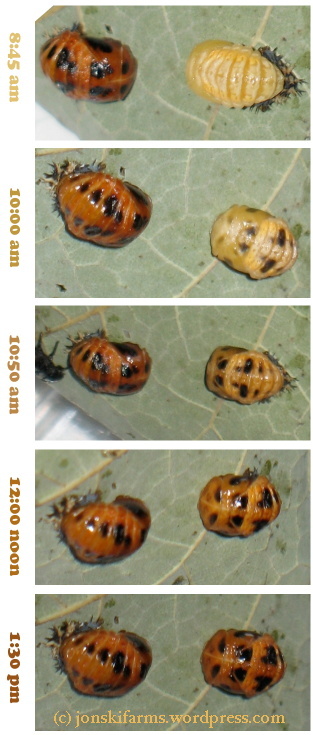23 April 2008
Earth Day Spectrum
Yesterday (Earth Day), my friend Kathy told me to go outside, so I did. After all, she’s a teacher, and we have to respect teachers. :^) I took the office camera, ostensibly to take pictures for a project, but mostly to see if the daffodil line was blooming. Along the way, I decided to capture a “spectrum” of colors. Unfortunately, I forgot to get a blue picture (the scilla are abundant this time of year, so I could have!). I also meant to capture a forsythia bush (more yellow!) if the battery held out, but I forgot. But even so, it was a nice break from the stuffy office…
(see more photos on Flickr – start at this magnolia and work back through the photostream until you get to the mosaics shown above)
17 October 2007
Ladybug pupation color change
Last week on my second time out (collecting for Z-boy’s class), I collected a ladybug pupa that was much paler than the others and didn’t have many spots. I wondered if this meant it was going to be a yellow beetle without spots (these multi-colored asian lady beetles have a wide color range), or if this meant it was a young pupa. I took another look at it later that evening, and it was orange and spotted. Was I imagining things? Had it really been yellow and spotless earlier? So imagine my excitement this morning when I noticed that the largest of my larvae was started to pupate, and it was in fact pale yellow without any spots. I kept my camera close at hand today, and documented the color change over four to five hours. Cool, huh? Now if I could just find out why they do those push-ups… (click on image for larger view)
16 October 2007
Ladybird Lifecycle
Last spring, we collected some tadpoles and watched them turn into toads. I documented the various stages of growth in a photoset that is available on Flickr.
Then last Monday, we were collecting invertebrates to give the classroom support staff on our project some experience with the curricular activities. Underneath one of the maple trees, I found a veritable treasure trove of ladybird beetle (aka ladybug) larvae, feasting on an abundance of aphids. Harkening back to my tadpole experience of the spring, I decided to collect some and watch them go through their metamorphosis. I also took some in to Z-boy’s class, because their science and social study units both currently focus on life stages.
This photo shows three of the life stages together (more photos at Flickr). The black and orange thing at the top (and the thing disappearing under the edge of the leaf) is a larva (like the caterpillar stage in a butterfly). Right in the middle of the photo is a pupa (similar to cocoon/chrysalis). The bottom right is an adult ladybird beetle. I’m not sure exactly when the adults emerged, because I didn’t check much over the weekend, but obviously it was before today! These are all the multi-colored Asian lady beetle species (scientific name: Harmonia axyridis).
I went to get more aphids to feed the larva yesterday, and found two more larvae of different sizes. I’m going to try to keep better track of when they hit the different stages.
Even though I know they’re not “dead” or anything, I’ve always assumed that pupae would stay still. So imagine my surprise when I saw them doing “pushups” – raising up the end that is not attached to the leaf. (Maybe headstand would be a more appropriate term?) Sometimes the end stays raised for minutes at a time, sometimes it happens quickly, sometimes in happens multiple times in fast succession. I have no idea what this is, and my brief web search is not revealing any scientific explanation. The largest of the larvae has stopped moving and started doing this same hind end lifting thing – maybe it’s about to pupate? Hmmm, maybe I should get out the video camera…






